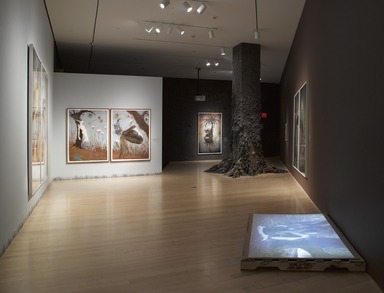

Echoes of Kara Walker’s African silhouettes, fused with collaged, sexualized imagery from glossy magazines, transform into sumptuous,
mixed media collages of powerful female figures in magical settings in Wangechi Mutu’s work. Although most works in
this exhibition are collages for which Mutu is known, "A Fantastic Journey" also
includes three video works and several installations that appear throughout the space of the show.
As part of the exhibition-wide installation, Mutu decorated several corners,
a door space and a column in a heavy, grey wool fabric held down by
packing tape that forms organic, root-like patterns with embedded red bras and
panties intermittently trapped in it. Within the Brooklyn Museum’s third floor, Wangechi Mutu’s
exhibition lies in an angled L shape around triangular Judy Chicago’s "Dinner Party" room, which Mutu's wool fabric installation, through its strange disbursement tries to keep consistent in its look. The
shorter part of the L ends in a boxed off area for collaboration Mutu undertook with Santigold- an animation titled The End of Eating Everything that stars a spore- spewing creature
with the head of a female model and a fantastical body that resembles a compilation
of images from Mutu’s collages. Within the same portion of the show, a second
video work, black and white performance documentation, Eat
Cake, stars Mutu
herself as a wild woman with unkempt hair and overgrown nails dressed in beautiful dress, eating a large chocolate
cake with her hands in the woods that looks more like a mound of dirt than a dessert. Meanwhile, Mutu’s innovative collages on Mylar that contain much of
symbolism of her African ancestry compete for attention within the same
space.
In the space
of the longer part of the L, collages such as Misguided
Little Unforgivable Hierarchies take over the
area and tell a fuller story of the artist’s political message of corruption in he native country through, provocative surfaces, symbols of both collaged images and body language and composition. In this work, confident female figures bent
over backwards are stacked on top of each other to show the crooked political attitude
toward women and people of Kenya. The surface is beautifully captivating with a
jumble of collaged pornographic and machine imagery and fluid, watercolor effects of paint
on the impermeable surface of Mylar, captivated in carefully structured silhouettes with barely any background. The underlying theme of Kenyan suppression reveals in works such as this giving strength and leverage to the rest of the show.
You describe two videos here but there were in fact three of them in the show: one was situated on the right, when entering the exhibition from the elevator. I don’t remember its name but it represented her in the ocean, while a song was playing (I think it was related to slavery). I am mentioning this video because I thought it was really compelling, almost hypnotizing, and it happened to be a great entrance to the show for me. So I am wondering why you overlooked it and I find it very interesting how we each take something different out of an exhibition.
ReplyDelete